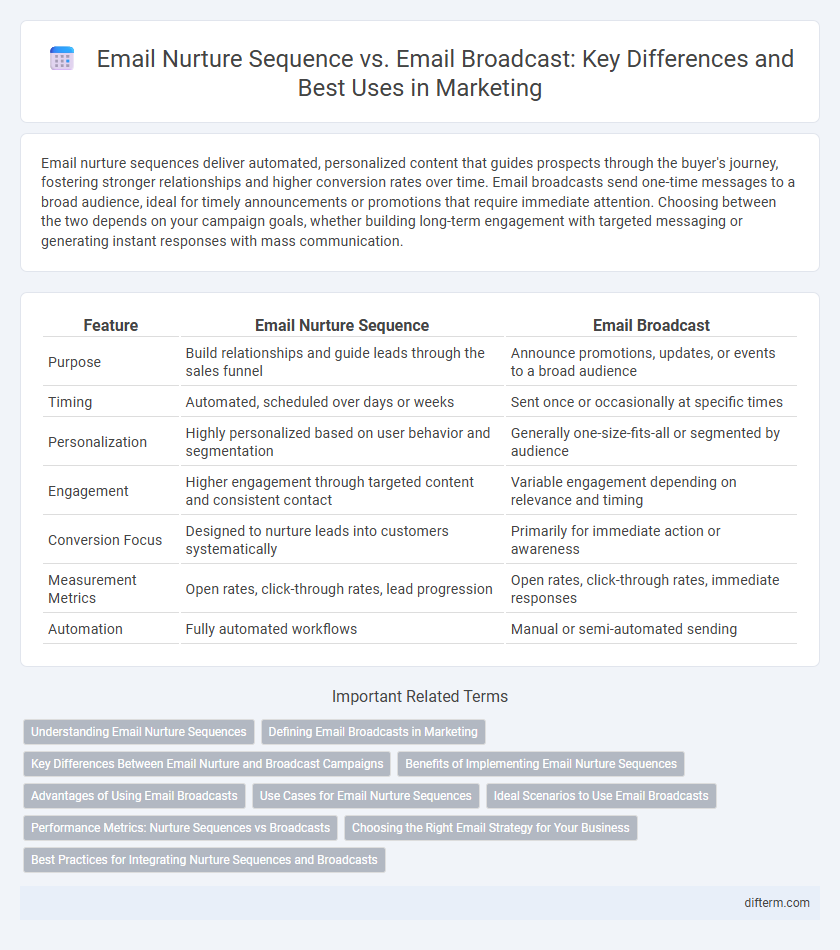Email nurture sequences deliver automated, personalized content that guides prospects through the buyer's journey, fostering stronger relationships and higher conversion rates over time. Email broadcasts send one-time messages to a broad audience, ideal for timely announcements or promotions that require immediate attention. Choosing between the two depends on your campaign goals, whether building long-term engagement with targeted messaging or generating instant responses with mass communication.
Table of Comparison
| Feature | Email Nurture Sequence | Email Broadcast |
|---|---|---|
| Purpose | Build relationships and guide leads through the sales funnel | Announce promotions, updates, or events to a broad audience |
| Timing | Automated, scheduled over days or weeks | Sent once or occasionally at specific times |
| Personalization | Highly personalized based on user behavior and segmentation | Generally one-size-fits-all or segmented by audience |
| Engagement | Higher engagement through targeted content and consistent contact | Variable engagement depending on relevance and timing |
| Conversion Focus | Designed to nurture leads into customers systematically | Primarily for immediate action or awareness |
| Measurement Metrics | Open rates, click-through rates, lead progression | Open rates, click-through rates, immediate responses |
| Automation | Fully automated workflows | Manual or semi-automated sending |
Understanding Email Nurture Sequences
Email nurture sequences deliver targeted, automated messages that guide prospects through the buyer's journey by providing personalized content based on user behavior and engagement. These sequences build relationships over time, increasing trust and conversion rates more effectively than one-time email broadcasts, which are designed for immediate announcements or promotions. Understanding the strategic use of nurture sequences allows marketers to segment audiences precisely and optimize campaign performance through tailored communication.
Defining Email Broadcasts in Marketing
Email broadcasts in marketing are one-time email campaigns sent to a segmented list or the entire subscriber base, designed to promote products, events, or timely offers. They aim to drive immediate action or engagement by delivering targeted content at specific moments. Unlike email nurture sequences, broadcasts focus on broad reach and timely communication rather than automated, ongoing relationship building.
Key Differences Between Email Nurture and Broadcast Campaigns
Email nurture sequences deliver targeted, automated messages designed to guide leads through the sales funnel over time, enhancing engagement and conversion rates. In contrast, email broadcast campaigns send one-time, mass emails aimed at announcements or promotions to a broad audience, prioritizing reach over personalization. Key differences lie in timing, personalization, and campaign goals: nurture sequences emphasize relationship-building with tailored content, while broadcasts focus on immediate communication to a wide subscriber base.
Benefits of Implementing Email Nurture Sequences
Email nurture sequences deliver personalized, automated content that builds stronger relationships by guiding leads through the buyer's journey with timely, relevant messages. These sequences increase engagement and conversion rates by addressing individual pain points and interests, fostering trust and brand loyalty over time. Compared to email broadcasts, nurture sequences reduce unsubscribes and improve ROI by targeting segmented audiences with strategically spaced communications.
Advantages of Using Email Broadcasts
Email broadcasts enable marketers to deliver targeted messages to a large audience simultaneously, increasing engagement rates and brand visibility. Using segmentation and personalization within broadcasts enhances relevance, drives higher open and click-through rates, and accelerates conversions. This approach offers flexibility for timely promotions, product announcements, and event invitations, maximizing marketing ROI.
Use Cases for Email Nurture Sequences
Email nurture sequences excel in guiding prospects through a personalized buyer's journey by delivering targeted, timely content that builds trust and encourages engagement over time. Ideal for onboarding new leads, promoting multi-step product launches, or re-engaging dormant customers, these sequences automate relationship-building with consistent, relevant messaging. Compared to email broadcasts, nurture sequences optimize conversion rates by tailoring communication based on user behavior and lifecycle stage, ensuring higher relevance and improved ROI in marketing campaigns.
Ideal Scenarios to Use Email Broadcasts
Email broadcast campaigns excel in delivering timely updates, such as product launches, flash sales, or company announcements, to a broad audience for immediate impact. They are ideal for promoting limited-time offers and events where urgency prompts quick action from recipients. Leveraging segmented lists within broadcasts ensures targeted messaging that boosts engagement rates and conversion potential.
Performance Metrics: Nurture Sequences vs Broadcasts
Email nurture sequences typically achieve higher engagement rates, with open rates averaging around 50% compared to 20-25% for broadcast emails. Click-through rates in nurture sequences can increase by up to 10%, driven by tailored content and timely delivery based on user behavior. Conversion rates also tend to be significantly higher in nurture campaigns, often doubling those of broadcast emails, due to sustained relationship-building and personalized messaging.
Choosing the Right Email Strategy for Your Business
Email nurture sequences build long-term relationships by delivering personalized, timely content that guides prospects through the sales funnel, boosting engagement and conversion rates. Email broadcasts are ideal for one-time announcements, promotions, or product launches, reaching a broad audience quickly to generate immediate response. Selecting the right email strategy depends on your business goals, customer journey stage, and desired interaction frequency to maximize ROI and customer retention.
Best Practices for Integrating Nurture Sequences and Broadcasts
To maximize engagement and conversions, align your email nurture sequences with broadcast campaigns by segmenting audiences based on behavior and preferences. Use nurture sequences for educating and building trust over time, then strategically send broadcast emails to promote time-sensitive offers or important updates. Consistently analyze performance metrics like open rates and click-through rates to refine timing, frequency, and content relevance for each email type.
Email Nurture Sequence vs Email Broadcast Infographic

 difterm.com
difterm.com